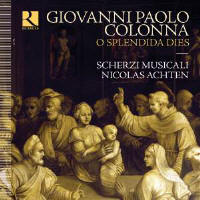Texte paru dans: / Appeared in:
|
|
|
Reviewer: Bertil
van Boer When I reviewed a set of Lamentations by Giovanni Paolo Colonna in the May/June issue of Fanfare (41:5) I made the comment that, although Colonna’s music was well worth a second look, it was probably a long shot that there would be a revival. Given that he was always historically in the shadow of Archangelo Corelli, with whom he feuded and lost, this did not seem out of place. Since then, however, we have recordings of a number of his works that have appeared, and so I must amend my view. To add to these now comes a recording of his Motetti a due e tre voci, published as his op. 3 in 1681 in Bologna. These are delightfully intimate pieces, scored for various combinations of two or three voices and continuo and meant for smaller sacred services where the more massive forces might be overwhelming. He was able to create a remarkably copasetic series that had various liturgical and secular uses, and indeed these were popular enough to engender no fewer than two reprints, one posthumous. The original dedication, as the rather nice notes by Nicolas Achten state, was for the election of a number of notables to the city senate, but he also mentions that they would have been suitable for the various sacred obligations of the famed Accademia Filarmonica. The motets themselves are not entirely long enough for a disc, and so Achten has chosen to insert some filler material to extend it out. Moreover, several of the original motets have been omitted. In the original publication there are 10 works; six for two voices and four for three. The conductor has chosen seven of these for the recording, even though they are not long enough in total (all 10, however, may have been a tad too long), and to provide a bit of contrast has included two of Colonna’s instrumental sonatas, as well as one by one of his colleagues at San Petronio, Giulio Cesare Arresti (1619–1701), another rather obscure figure. His Sonata XVI was published in 1697 and thus is over a decade after Colonna’s collection was published. The performers of the Scherzi Musicale have gone to great pains to research the performance practices that Colonna might have used during the time when these pieces were written. This includes a higher pitch (A=440 Hz), which may seem modern but was apparently how the organ at the church of San Petronio was tuned. There was a modification in the tuning as a nod towards the meantone, which makes the dissonances a bit more pungent, but which also allows for the ability to modulate into keys that would have been difficult with other tunings. That being said, the music speaks for itself. The Salve pretiossum begins hauntingly with a soft languid countertenor, which floats easily as a flowing invitation to the banquet of the saints. As the soprano and baritone enter, each weaves a liquid arabesque that is gentle and perhaps even a bit pastoral. The counterpoint is restrained, though there are moments when the voices become more active in terms of coloratura, reaching an apex in the Alleluia. Advolate fideles has a short intro for the lute, but when the two sopranos enter they echo each other in a lively duet that twirls about most lyrically. The two Colonna sonatas (VII and VIII) are less interesting, as they seem rather tame; the latter is done as a sort of lute trio (a lute and two theorbos) like a sort of duo dance with a rather jaunty rhythm, and the latter is more contrapuntal with a chromatically gnarly theme that fits the organ well. Arresti’s contribution is entitled an “Elevation” or a sort of variation on the Pange lingua chant that forms a rather solemn cantus firmus and foil for the lute postlude that sounds a bit like a lute song. (The final instrumental works are a pair of “Sinfonias” that have been cobbled together from vocal movements, each of which could easily have been omitted.) Of the remaining motets, my favorite is E libano cæli, with its sonorous counterpoint right off the bat, and a development of the interweaving voices that seems right out of a Cavalli opera. The rhythmic structure is light and bouncy, like a joyous dance. Following this is a floating melody for the soprano accompanied by the theorbo continuo that hovers between recitative and arioso before evolving into a duet with the countertenor. The flowers of the text are outlined in extremely flowery coloratura in all of the voices that become even more complex in the final Alleluia. If nothing else, this establishes Colonna’s position as one of the major composers of sacred music of the period. His music is well written and often sensitive to the painting of the text. He is also a master of easy counterpoint, wherein the lines fit together like a puzzle and yet do not avoid coloratura. To make this all happen requires the talents of a first-rate ensemble. The Scherzi Musicali provides this interaction with ease and dexterity. The straight sound vocal lines blend easily together and with the fine continuo group that seems a bit larger than conventional. The soprano of Wei-Lian Huang is clear and bright, while the countertenor of Leandor Marziotte is flexible and blends well. The other sopranos, Gwendoline Blondeel and Grier de Geyter, are equally as clear, and conductor Nicolas Achten does have the lighter baritone that this style of music requires. I am glad, for one, that my hesitancy about the revival of Colonna’s music can now be revised. This is one excellent disc. | |
|
|
|
|
|
|
|
Cliquez l'un ou l'autre
bouton pour découvrir bien d'autres critiques de CD |
|




